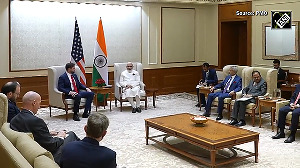Sony Entertainment Television's executive vice president (ad sales) Rohit Gupta is quite kicked. Pepsi has just signed up as the sixth sponsor for Indian Idol, the channel's popular new music-based reality show.
"Indian Idol is driving both viewership and revenue for Sony. We're charging advertisers a premium and spot buyers are now coming in," Gupta says gleefully.
Less than two months after its launch, the show is averaging a television rating of 5.5 and has Procter & Gamble, Airtel, Nokia, Marico and Godrej among its sponsors.
Yet Indian Idol is not the only programme that's keeping Gupta in high spirits -- it's been a good year for Sony, he says. Sony's chief executive officer Kunal Dasgupta echoes the point: "We've seen steady growth and consolidated our business. Our shows have been innovative, with top-of-the-mind recall."
A mix of old and new programmes has helped Sony: while Kkusum and CID were revived, Yeh Meri Life, Jassi Jaisi Koi Nahin and Indian Idol were introduced.
Consequently, say Sony executives, the channel's revenues have jumped by 30 per cent from last year's level. That's more than the industry average of 25 per cent.
A 20 per cent hike in advertising rates combined with the emergence of new advertising from the petroleum, telecommunications and the financial services industries helped bolster revenue growth.
Predictably, the Rupert Murdoch-controlled Star India's Hindi entertainment channel Star Plus is feeling the heat -- or so some advertisers and media planners would have you believe.
"Star Plus seems to be under pressure," says the director of a leading telecom company. The latest Television Audience Measurement figures on the shares of all channels in the Hindi speaking market back the point.
Star Plus has lost market share, from 21 per cent to 19 per cent, between January and November 2004. Says media specialist Optimum Media Directon India's chief executive officer Sandip Tarkas: "Sony's channel share has improved from an average of approximately 5.5 per cent to 6.2 per cent, thanks to its new programmes.
"With a 19 per cent share, Star is now three times Sony -- it was four times its size at the beginning of the year. And that should worry Star."
Mind you, Star Plus accounts for a good chunk of Star India's revenue. Star India chief executive Peter Mukerjea and Sony executives decline to furnish figures, but media industry insiders reckon that Star Plus rakes in Rs 750 crore (Rs 7.5 billion) in revenue a year -- and that Star India's annual revenues are anywhere between Rs 1,200 crore (Rs 12 billion) and Rs 1,400 crore (Rs 14 billion).
Sony's ad revenue is said to be about Rs 350 crore (Rs 3.5 billion) -- Rs 550 crore-Rs 600 crore (Rs 5-6 billion), for Sony Entertainment Television.
Still, not everyone agrees that Star Plus is losing ground. Media audit company Spatial Access Solution's managing partner Meenakshi Madhvani, for one.
Says she: "Star Plus's audience share has declined marginally but its revenues have not been impacted as yet. Clearly, there's a built-in inflation that is enabling this position."
According to a SAS analysis based on value estimates at average market rates, Star Plus continued to gross an estimated Rs 40 crore (Rs 400 million) a month (four week average) from its top five shows (Kyunki Saas..., Kahaani Ghar Ghar Ki, Kasuati, Des Mein.. and Kehta Hai Dil) after Sony launched "Indian Idol."
Sony's ad volume hasn't increased dramatically either after "Indian Idol" was launched, she says. Overall, after "Indian Idol was launched in October, Sony sold 25 per cent less ad space than Star Plus' 94 per cent, adds Madhvani.
But Sony's executive vice president (programming) Tarun Katial says that Star Plus has also lost out on weekly Gross Rating Points, a measure that sums up television rating points and something that's critical for media buyers.
Star Plus' GRPs have dropped from 400 to about 290 this year, while Sony's have gone up from 70 to 100. Adds Katial. "The leader would not have invested $40 million in two new channels (Star Utsav and Star One) if it was not under pressure." Agrees Tarkas: "Star One does seem like as if it was designed to take on Sony."
But Star's Mukerjea dismisses all this. He says Star One and Star Utsav complement Star Plus and Star Gold in offering a complete bouquet of Hindi television entertainment to different segments of the population.
"India's cable penetration is 50 per cent and we have a long way to go. We want more people, who do not watch TV, to have a reason to watch TV. We want more advertisers who have never advertised on cable to advertise with us. It is all about growing the pie," he says.
Advertisers and advertising experts, however, believe that the gambit really is to block advertisers from moving to rival channels "and create a plethora of brands so that there is competition within rather than outside," says the telecom company director.
Whatever be the reason for the launch of new channels, with increasing media fragmentation all television channels need to work harder to hold on to their advertisers.
"Star Plus is still India's premier entertainment channel but the increasing level of fragmentation (where audiences are watching different things) in the last one year is surely something to chew on. The tremendous growth in news channels is a pointer to that," says Tarkas.
Ironically, Star seems to be accelerating fragmentation in the market by launching new channels and also trying to control it.
Some marketing heads of companies also contend that Star Plus has not been able to tap the growing category of small and medium advertisers either. As the market leader, Star Plus has maintained its premium and attracted big advertisers.
But the growing number of small and medium-sized advertisers looking for lower rates and more frequency are finding Sony effective, says the telecom company director.
Sony's Gupta says last year the government changed the exports norm obligations for advertisers buying space on channels uplinked outside India. "This has led to an upsurge in the number of SME advertisers who're looking at television."
Indeed, several advertisers feel that Star needs to re-orient its strategy to address this segment.
Mukerjea demurs. "I do believe that Star offers packages tailored to different advertisers. The key here is really about the effectiveness of Star as a medium for advertisers to reach their consumers according to demographics. Star Utsav, hopefully, addresses the needs of small and medium advertisers."
In fact, planning experts feel that smaller advertisers may get attracted to Sony also because the channel traditionally has had better power ratios -- that is, Sony has been able to convert its viewership into revenue more effectively.
Retorts Mukerjea: "I don't know which media planners you have talked to -- perhaps I should talk to them to come on board! According to our information, our share of advertising reasonably reflects the popularity of our channels. However, I believe there is always room for improvement and we constantly look towards that."
Yet some advertisers predict that the pressure on Star Plus is set to increase and that explains why the channel is busy signing up long-term deals with advertisers.
The telecom company executive says that Star is aggressively pushing advertisers to sign long-term contracts with Star Plus -- based on the existing television rating points of programmes.
"This will protect the channel's ad revenue if viewer fragmentation becomes more pronounced," he says.
Mukerjea admits that Star has been offering "preferred air time rates to advertisers who are willing to enter into long-term deals. They will get the benefit of rate protection for the duration of the contract."
But some advertisers are chary of signing on for the long term, in part because they think that ad rates in the industry, including Star, seem to have stabilised.
R L Ravichandran, vice president (marketing) at Bajaj Auto, says that the two-wheeler company shuns long-term contracts. "Our advertising is based on product launches and building the brand name. We want the flexibility to withdraw if required," he says.
Ravichandran also adds: "We do not have any channel loyalty. We look at programmes and their popularity and evaluate the most effective way to reach our audience."
The Sony brass, meanwhile, is busy devising ways to keep its audiences and in turn advertisers riveted. "Indian Idol" will be followed by a new show (whose copyright is held by a Dutch firm) on India's best dancing couple.
Its highly popular crime thriller CID is being supplemented with a new show CID Special Bureau. Aahat II, a well-established horror show, is to be revived.
On its part, Star will focus on Star One and add more regional language channels to the network's bouquet. Mukerjea, however, says it is "premature to spell out our regional language strategy." Besides, Mukerjea is not fazed by Sony's plans.
"Star Plus has remained the undisputed number one satellite channel in India for the last four years. It dominates every genre and time band on Indian television," he says.
The Star group's earnings shot up substantially last year, largely on the strength of thriving business in India. "We expect the group to achieve double digit growth," Mukerjea says confidently.
Kajal Thakore, a senior executive at media planning and buying company Optimum Media Solution, too agrees. Says she: "Star Plus is still the leader and there is no immediate threat to the channel."
That may be true but both Mukerjea and Thakore would do well to bear in mind that the television market is in for more fragmentation -- at least 20 new channels (some put the number at 50) will be on air next year.
Star's challenges
-
Star Plus has lost 2 per cent channel share between January and November 2004 among all channels in the Hindi speaking market
-
Sony claims that the Star Plus's weekly GRPs have dropped from 400 last year to 290 this year
-
Advertisers spending big money on cricket prefer a cheaper channel option
-
Audience fragmentation is pushing advertisers to look at niche channels
- Star Plus may be losing out on small and medium advertisers who look for lower rates and higher ad frequency








 © 2025
© 2025